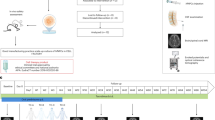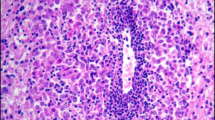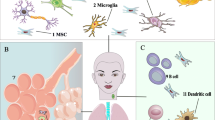Abstract
Currently, autologous bone marrow-derived stem cell is one of the most innovative areas of stem cells research. Previous studies on animal models of nervous system diseases have shown that these cells have a good effect on nervous system disorders. The alternative treatment with stem cells for the nervous system diseases has also gradually reached to clinical application stage. The prospect is captivating, but the safety and efficacy of this procedure need further research. To observe the clinical efficacy and side effects of the treatment for autologous mesenchymal stem cells and neural stem/progenitor cells which are in differentiated form by inducing with cerebrospinal fluid in the patients with nervous system diseases, thirty patients were selected from our hospital (2009-10 to 2012-07) and were followed at 1 month, 3 months, 6 months, 1 year and 2 years after the treatment with autologous mesenchymal stem cells and neural stem/progenitor cells in differentiated form was introduced. In this paper, we will introduce the process to make cells accessible for the clinical application by the description of the changes observed in 7 cases were followed for 2 years. The time for bone marrow mesenchymal stem cells could be available for clinical needs is as early as 5 days, not later than 10 days, and the median time is 8 days, while neural stem/progenitor cells in differentiated form can be available for clinical needs in as early as 12 days, not later than 15 days, and the median time is 13.5 days (statistical explanation: Case 5 only uses autologous mesenchymal stem cells, and Case 7 has two times bone marrow punctures). The neurological function of the patients was improved in 1-month follow-up, and the patients have a better discontinuous trend (statistical explanation: sometimes the neurological function of the patients between two adjacent follow-ups does not change significantly). After transplantation, four patients appeared to have transient fever, but it was easily controlled by symptomatic treatment. Seven patients did not appear to show secondary tumor induced by transplantation of stem cells in 2-year follow-up. Thus, it suggests that the use of autologous bone marrow-derived stem cells transplantation in patients with nervous system diseases is a feasible, convenient, safe, and effective method.



Similar content being viewed by others
References
Shevde, N. (2012). Stem cells: Flexible friends. Nature, 483(7387), S22–S26.
Shan, L.-D. (2004). Inducing bone marrow stromal cells to differentiate into nerve cells and using them to treat Parkinson’s disease. Suzhou University.
Zan, K., & Geng, D.-Q. (2009). Treatment of cerebrovascular disease with stem cell transplantation and gene therapy. Chinese Journal of Postgraduates of Medicine, 32(13), 7–9.
Ye, Y., Wan, M. R., & Dai, R. F. (2009). Induction of human bone marrow mesenchymal stem cells differentiation into neural stem/progenitor cells using cerebrospinal fluid. International Journal of Anesthesiology and Resuscitation, 30(5), 394–398.
Ye, Y., Zeng, Y. M., Wan, M. R., & Lu, X. F. (2011). Induction of human bone marrow mesenchymal stem cells differentiation into neural-like cells using cerebrospinal fluid. Cell Biochemistry and Biophysics, 59(3), 179–184.
Chen, L., Xi, H. T., & Huang, H. Y. (2007). Introduction of international cooperative ataxia rating scale. Chinese Journal of Clinical Rehabilitative Tissue Engineering Research, 11(39), 8005–8007.
Huang, H. Y., Chen, L., et al. (2008). Minutes of the first international neural repair society annual meeting. Chinese Journal of Reparative and Reconstructive Surgery, 22(8), 1018–1023.
Heesen, C., Nawrath, L., Reich, C., et al. (2006). Fatigue in multiple sclerosis: An example of cytokine mediated sickness behaviour? Digest of the World Core Medical Journals: Clinical Neurology, 2(5), 44.
Ma, Y. S., Chen, L., Yi, L. K., et al. (2008). Evaluation of comatose patients prognostic using GCS, ICS and APACHE II the three clinical score. Chinese General Practice, 11(19), 1761–1762, 1765.
Huang, H. Y. (2007). Olfactory ensheathing cell transplantation (pp. 69–84, 148–323). Beijing: Science Press.
Jackson, E. L., & Alvarez-Buylla, A. (2008). Characterization of adult neural stem cells and their relation to brain tumors. Cells Tissues Organs, 118(10), 212–224.
Prockop, D. J., Gregory, C. A., & Spees, J. L. (2003). One strategy for cell and gene therapy: Harnessing the power of adult stem cells to repair tissues. Proceedings of the National Academy of Sciences USA, 100(Suppl. 1), 11917–11923.
de Vasconcelos Dos Santos, A., da Costa Reis, J., Diaz Paredes, B., Moraes, L., Jasmin Giraldi-Guimaraes, A., & Mendez-Otero, R. (2010). Therapeutic window for treatment of cortical ischemia with bone marrow-derived cells in rats. Brain Research, 1306, 149–158.
Hayase, M., Kitada, M., Wakao, S., Itokazu, Y., Nozaki, K., Hashimoto, N., et al. (2009). Committed neural progenitor cells derived from genetically modified bone marrow stromal cells ameliorate deficits in a rat model of stroke. Journal of Cerebral Blood Flow and Metabolism, 29, 1409–1420.
Lee, D. H., Ahn, Y., Kim, S. U., Wang, K. C., Cho, B. K., Phi, J. H., et al. (2009). Targeting rat brainstem glioma using human neural stem cells and human mesenchymal stem cells. Clinical Cancer Research, 15, 4925–4934.
Lee, J. K., Jin, H. K., & Bae, J. S. (2009). Bone marrow-derived mesenchymal stem cells reduce brain amyloid-beta deposition and accelerate the activation of microglia in an acutely induced Alzheimer’s disease mouse model. Neuroscience Letters, 450, 136–141.
Song, C. H., Honmou, O., Ohsawa, N., Nakamura, K., Hamada, H., Furuoka, H., et al. (2009). Effect of transplantation of bone marrow-derived mesenchymal stem cells on mice infected with prions. Journal of Virology, 83, 5918–5927.
Amano, S., Li, S., Gu, C., Gao, Y., Koizumi, S., Yamamoto, S., et al. (2009). Use of genetically engineered bone marrow-derived mesenchymal stem cells for glioma gene therapy. International Journal of Oncology, 35, 1265–1270.
Venkataramana, N. K., Kumar, S. K., Balaraju, S., Radhakrish-nan, R. C., Bansal, A., Dixit, A., et al. (2010). Open-labeled study of unilateral autologous bone-marrow-derived mesenchymal stem cell transplantation in Parkinson’s disease. Translational Research, 155, 62–70.
Fleischman, R. A., Simpson, F., Gallardo, T., Jin, X. L., & Perkins, S. (1995). Isolation of endothelial-like stromal cells that express Kit ligand and support in vitro hematopoiesis. Experimental Hematology, 23(13), 1407–1416.
Takahashi, T., Kalka, C., Masuda, H., Chen, D., Silver, M., Kearney, M., et al. (1999). Ischemia- and cytokine-induced mobilization of bone marrow-derived endothelial progenitor cells for neovascularization. Nature Medicine, 5(4), 434–438.
Fukunaga, A., Uchida, K., Hara, K., Kuroshima, Y., & Kawase, T. (1999). Differentiation and angiogenesis of central nervous system stem cells implanted with mesenchyme into ischemic rat brain. Cell Transplantation, 8(4), 435–441.
Berezovskaya, O., Maysinger, D., & Fedoroff, S. (1996). Colony stimulating factor-1 potentiates neuronal survival in cerebral cortex ischemic lesion. Acta Neuropathologica, 92(5), 479–486.
Maestroni, G. J., Cosentino, M., Marino, F., Togni, M., Conti, A., Lecchini, S., et al. (1998). Neural and endogenous catecholamines in the bone marrow. Circadian association of norepinephrine with hematopoiesis? Experimental Hematology, 26(12), 1172–1177.
Eglitis, M. A., Dawson, D., Park, K. W., & Mouradian, M. M. (1999). Targeting of marrow-derived astrocytes to the ischemic brain. NeuroReport, 10(6), 1289–1292.
Zhang, Z. X., Guan, L. X., Zhang, K., Zhang, Q., & Dai, L. J. (2008). A combined procedure to deliver autologous mesenchymal stromal cells to patients with traumatic brain injury. Cytotherapy, 10, 134–139.
Xiong, Y., Mahmood, A., & Chopp, M. (2009). Emerging treatments for traumatic brain injury. Expert Opinion on Emerging Drugs, 14(1), 67–84.
Low, C. B., Liou, Y. C., & Tang, B. L. (2008). Neural differentiation and potential use of stem cells from the human umbilical cord for central nervous system transplantation therapy. Journal of Neuroscience Research, 86(8), 1670–1679.
Kang, X. Q., Zang, W. J., Bao, L., et al. (2006). Differentiating characterization of human umbilical cord blood-derived mesenchymal stem cells in vitro. Cell Biology International, 30(7), 569–575.
Woodbury, D., Schwarz, E. J., Prockop, D. J., et al. (2000). Adult rat and human bone marrow stromal cells differentiate into neurons. Journal of Neuroscience Research, 6(4), 364–370.
Kogter, G., Sensken, S., Airey, J. A., et al. (2004). A new human somatic stem cell from placental cord blood with intrinsic pluripotent differentiation potential. Journal of Experimental Medicine, 200(2), 123–135.
Yong-zhou, S., Hui-xian, C., Zhe, L., et al. (2008). Effects of brain homogenate on the differentiation of rat bone mesenchymal stem cells into neuron-like cells following traumatic brain injury. Journal of Clinical Rehabilitative Tissue Engineering Research, 12(3), 461–464.
Jia, Y. J., Yang, Y. J., Zhou, Y., et al. (2002). The study of inducing rat bone marrow stromal cells to differentiate into neural cells by using baicalin. Chinese Medical Journal, 82(19), 1337–1341.
Lim, J. Y., Park, S. I., Oh, J. H., et al. (2008). Brain-derived neurotrophic factor stimulates the neural differentiation of human umbilical cord blood-derived mesenchymal stem cells and survival of differentiated cells through MAPK/ERK and P13 K/Akt-dependent signaling pathways. Journal of Neuroscience Research, 86(10), 2168–2178.
Rivera, F. J., Sierraha, W. D., Mingnell, J. J., et al. (2006). Adult hippocampus derived soluble factors induce a neuronal-like phenotype in mesenchymal stem cells. Neuroscience Letters, 406(1–2), 49–54.
Sanchez-Ramos, J., Song, S., Cardozo-Pelaez, F., et al. (2000). Adult bone marrow stromal ceils differentiate into neural cells in vitro. Experimental Neurology, 164, 247–256.
Deng, W., Obrocka, M., Fischer, I., et al. (2001). In vitro differentiation of human marrow stromal cells into early progenitors of neural cells by conditions that increase intracellular cyclic AMP. Biochemical and Biophysical Research Communications, 282, 148–152.
Kim, B. J., Seo, J. H., Bubien, J. K., et al. (2002). Differentiation of adult bone marrow stem cells into neuro progenitor cells in vitro. NeuroReport, 13(9), 1185–1188.
Rismanchi, N., Floyd, C. L., Berman, et al. (2003). Cell death and long-term maintenance of neuron-like state after differentiation of rat bone marrow stromal cells: A comparison of protocols. Brain Research, 991, 46–55.
Cao, Z. Y., Liu, H., Shan, J. J., Zhu, M. H., et al. (2011). The alternative-treatment with autologous mesenchymal stem cells for diseases of the nervous system in seven cases. Chinese Journal of Clinical Rehabilitative Tissue Engineering Research, 1, 163–166.
Wang, P. (2009). The study of isolating and culturing of bone marrow mesenchymal stem cells and the influence of cerebrospinal fluid on bone marrow mesenchymal stem cells (pp. 1–55). The graduate thesis of Soochow University (no. 20090501).
Shen, Y. X., Wang, P., Shi, E. D., et al. (2011). Culturing of bone marrow mesenchymal stem cells in vitro with cerebrospinal fluid. Chinese Journal of Clinical Rehabilitative Tissue Engineering Research, 15(36), 6802–6806.
Yang, H. Y., Gu, R., Wang, W. J., et al. (2009). The cerebrospinal fluid promotes the differentiation of neural stem cells after transplantation of bone marrow mesenchymal stem cells. Chinese Journal of Laboratory Diagnosis, 13(3), 300–302.
Zeng, K. B., Wang, X. F., & Yan, Y. (2003). The effect in growth of bone marrow stromal cells in vitro of cerebrospinal fluid. Chinese Journal of Contemporary Neurology and Neurosurgery, 11(2), 96–99.
Freedman, M. S., & Uccelli, A. (2012). Neurorepair with mesenchymal stem cells: Hope or hype? Lancet Neurology, 11(2), 123–125.
Author information
Authors and Affiliations
Corresponding author
Rights and permissions
About this article
Cite this article
Ren, C., Geng, Rl., Ge, W. et al. An Observational Study of Autologous Bone Marrow-Derived Stem Cells Transplantation in Seven Patients with Nervous System Diseases: A 2-Year Follow-Up. Cell Biochem Biophys 69, 179–187 (2014). https://doi.org/10.1007/s12013-013-9756-8
Published:
Issue Date:
DOI: https://doi.org/10.1007/s12013-013-9756-8




